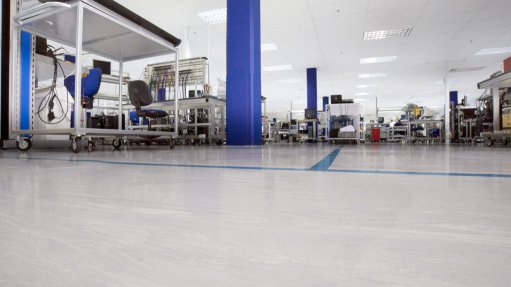
INDUSTRIAL APPLICATION Static dissipative flooring eliminates electron imbalances and decreases faulting electronic equipment
Static control solutions provider Altico completed two static dissipative (SD) flooring installations last month for electronic repairs franchise weFix at Balito Lifestyle Centre, in KwaZulu-Natal, as well as at the Vaal Mall, in Gauteng.
“The SD flooring is a hard-wearing homogeneous contact sheet or tile floor covering engineered specifically for electrostatic discharge (ESD) protection. It removes an electron imbalance that a person may have owing to static electricity, so that it does not affect electronics that they come in contact with,” says Altico technical sales manager Nick Sibanda.
The ESD flooring range varies according to its electrical resistance level, from the standard SD flooring to electrostatic conductive (EC) and fully conductive flooring.
Sibanda explains that EC flooring has a higher electrical resistance level and is used in highly sensitive electronic manufacturing or industrial environments, while conductive flooring, which is fully carbon based, is used for explosives and ammunition manufacturing applications, as well as by various original-equipment manufacturers in the military industry, where fatalities can occur owing to static electricity triggering malfunctions.
“SD flooring is used for electronic stores and environments that use telecommunications to reduce the amount of faulty devices owing to static damage,” he adds.
Sibanda says that Altico, a division of Actum Electronics, is growing from strength to strength because of a strong demand for antistatic solutions.
Actum Group MD Kevin Klaff adds that, as the world becomes more technical, the need to manage technical components – especially in midland areas, since the air is drier than it is in humid coastal regions – becomes greater.
“There is a growing high-end manufacturing industry in South Africa which needs to comply with a uniformed standard for anti-static solutions, as people need to be correctly earthed to avoid electronic faults and increase safety,” he avers.
Before installation, Altico carries out an evaluation of moisture levels and the foundation of the building to determine whether the conditions are suitable for the antistatic flooring, Sibanda points out.
“Testing old buildings comes with various challenges because it requires thorough assessments of moisture levels and it is often a time-consuming exercise to remove old vinyl tiles or carpets before the installation of ESD flooring.”
After an ESD flooring installation, Altico provides the client with maintenance guidelines and specialised products to clean the floor to ensure consistent quality.
Altico also issues ESD-compliance certificates, which indicate the flooring specification.
“The certification complies with European standards and allows for product exports, since it is manufactured in a controlled room environment,” notes Klaff, adding that Altico is the only antistatic solutions provider that provides ESD compliance certification in South Africa.
Altico tests clients’ flooring and updates the certification yearly as an added service for five to six years after an installation, says Sibanda.
“With technology advancing, we have seen a spike in demand for our products. In the past, we did about one floor a month – now we foresee us installing several floors a month,” he concludes.